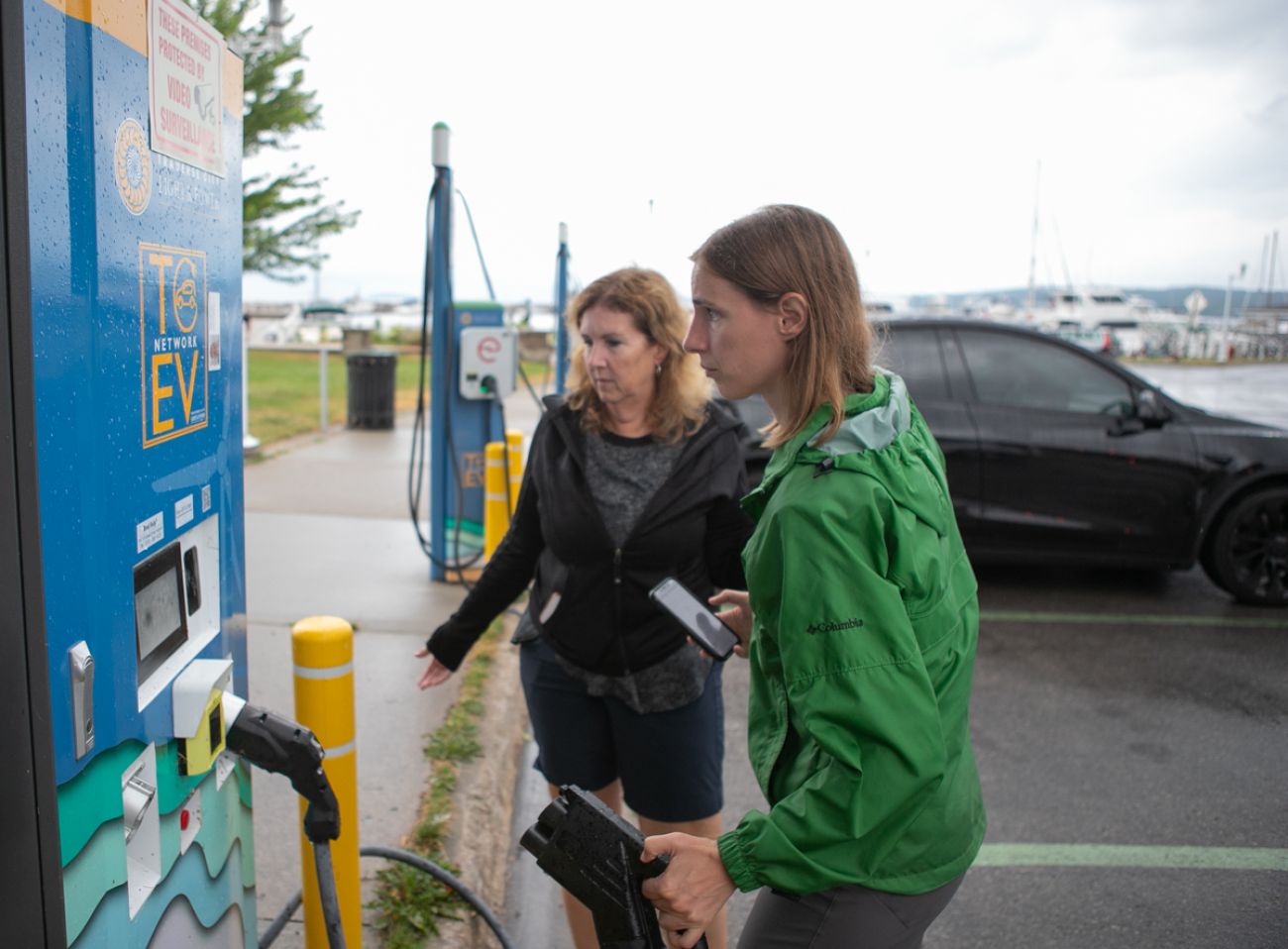Road trips are key to making EVs work in Michigan. They’re doable now. Barely

- Automakers and government officials have vowed to get most American drivers into EVs in the coming years
- Experts say seamless road trips are the key to convincing consumers to make the switch
- Today, road trips are doable, but even with tons of preparation and alternate plans, remain far from seamless
SLEEPING BEAR DUNES — Stunning sandy beaches and turquoise waters make this stretch of Lake Michigan a national treasure, drawing 1.6 million annual visitors who often drive long distances to see it.
Last week, on a hot summer day, thousands came to tackle its popular Dune Climb. But within a half-hour drive from the landmark near Empire, there was only one publicly accessible electric charger — and it was compatible only for Tesla drivers and those with special adapters.
Lines aren’t uncommon to use it, and some fear the lack of chargers could deter EV owners from planning vacations at Sleeping Bear Dunes.
“It is the economic engine for this area,” said Kerry Kelly, who chairs the board of the nonprofit Friends of Sleeping Bear Dunes. “So anything that limits that, it seems like you would address it.”
Related:
- Gretchen Whitmer is all-in on EVs. But state’s fleet is almost all gas powered
- EV road tripblog: Read about Bridge's 1,100-mile adventure around Lake Michigan
- Up North businesses help fill Michigan’s EV charging station gap
- Michigan’s EV evangelists luring 'fence-sitters' away from gas cars
Nearly three years after Gov. Gretchen Whitmer announced a multistate initiative for a lakeshore public charging network geared toward tourists, the so-called Lake Michigan Circuit remains spotty at best in many areas — as Bridge Michigan reporters discovered firsthand last week.
Chargers are often many miles apart and don’t always work. When they do, there are sometimes lines. And uniformity remains a hassle — some chargers only work for certain vehicles, while apps don’t work for every charger, requiring a half-dozen apps for longer trips.
These aren’t mere inconveniences. Less than 1% of cars on Michigan roads are EVs, about 45,000, and experts say road trips are a crucial barrier to overcome to persuade EV-curious drivers like Tracy Dobson to make the switch.
“What’s holding us back is the fear of strandings, or having to wait long times at a charger,” said Dobson of Montague.
Michigan plans to add 23 public chargers along the Lake Michigan route soon, and has $5 million more to install dozens more. But experts say more than 750 are needed, which will cost a total of $20 million.
Why road trips matter
Ninety-nine days out of 100, the average EV driver with an at-home charger will have a cheaper and easier time refueling than gas car drivers.
That’s because most Americans drive fewer than 30 miles a day. The average EV has a battery range of 270 miles per charge, and at-home charging costs about one-third the price of gasoline.
But road trips are a time-honored American tradition — and they are remembered far longer than everyday trips, making them the ultimate litmus test for EVs.
“We all want to take road trips at some point,” said Mehrnaz Ghamami, a Michigan State University researcher who has studied Michigan’s charging needs. Well-distributed chargers, including plenty of fast ones, are “crucial” to making that possible.
Now, Lake Michigan’s network falls far short.
Last week, Bridge Michigan embarked on a 1,100-mile trip from Ann Arbor to Muskegon, up to St. Ignace and Menominee before heading south into Wisconsin and returning to Ludington on the SS Badger car ferry.

A few caveats: Bridge relied on a rental car and didn’t know what it would get before picking up the car from a rental agency. We got a Chevy Bolt, which has a slow charging rate and is considered far less than ideal for road trips.
The verdict: We made it, but not without a fair amount of stress.
We meticulously planned the route around public charges compatible with the Bolt. Lodging was selected with overnight charging.
Even so, sometimes, there were simply no overnight charging options, which meant we spent more of our day sitting in the car waiting for a recharge. We had to download multiple payment apps and navigate widely-varying pricing structures at chargers.
This wasn’t exactly a surprise.
Before we set out, one seasoned EV driver advised us to plan as if we were embarking on a gas-powered road trip in Alaska, which has just a few hundred gas stations across a landmass 10 times Michigan’s size.
“You need to know where the stations are, and you need to plan ahead,” said Karl Bloss, who hasn’t owned a gas vehicle since 2018. And even then: “Always have a Plan B…and sometimes a Plan C.”
Experts say that needs to change if automakers and lawmakers hope to meet their shared goal of getting most drivers into EVs within the next decade.
The average driver is not willing to do that much prep work before hitting the road, said Cristina Benton, senior consultant with Anderson Economic Group in East Lansing.
And drivers want the freedom to make spontaneous changes to their travel plans, like veering off-course to explore a tourist attraction without worrying about whether there’s a place to charge nearby.
“Michigan drivers know that they can find a gas station to fuel their vehicle,” Benton said. “It has to be similar to that experience for EV drivers.”
At present, there are about 230 Level 2 chargers (which take several hours to fill a battery) and 33 fast chargers (which average about 30 minutes) along the Lake Michigan Circuit route.
That means drivers must be vigilant about planning stops, and patient if they arrive to find someone else plugged in. And they can never let the battery get too low, lest they encounter a broken charger and must drive dozens of miles to the next one.
Michigan leads other states
Despite the spotty chargers along Michigan’s 600-mile stretch of Lake Michigan coastline, the state is doing a better job of building out the 1,100-mile circuit than its neighbors.
Unlike them, Michighan has a clear goal of 763 new chargers within 10 miles of the lake, and about $6 million in state funding available to start installing them.
Neither Wisconsin nor Illinois have dedicated any state funding to the circuit, or figured out how many chargers are on the route today, according to information provided by state spokespeople. Indiana officials did not respond to questions from Bridge Michigan.

So what would a fully-functioning charging network look like?
Lots more plug points, in places where tourists already tend to stop, said Ghamami of MSU, who led a study identifying the circuit’s needs. Fast chargers would be near highway exits for travelers refueling on the go, while slower Level 2 chargers would be common at hotels, restaurants, beach parking lots and other places where people tend to linger.
Researchers found Michigan could get away with spending less than $20 million, though drivers would be inconvenienced. Spend too little, they warned, and spotty chargers or long lines could dissuade EV tourists from traveling the circuit at all.
Julie Staveland, an assistant division director at the Michigan Department of Environment, Great Lakes and Energy who is overseeing the department’s Lake Michigan Circuit strategy, estimated it has enough money today to complete about 15% of the route.
“We know the money that we have right now isn't enough,” she said. Getting the legislature to authorize more, “is going to be an uphill battle.”
But Ghamami said it doesn’t need to happen all at once. Her research group’s recommendation for 763 chargers is based on an assumption of 25% EV market share — a dramatic increase in EVs that’s “not going to happen tomorrow.”
In Sleeping Bear, with its throngs of visitors and lack of chargers, resourceful EV drivers have found workarounds by plugging in at campsites intended for RVs.
At times, it has created problems at the popular Platte River Campground, said Kelly of the Sleeping Bear Dunes nonprofit.
“They’re actually having some failures of the electric system because of the overload of charging EVs,” he said.
Modest relief is coming, after a $105,000 state grant to install two stations outside Cherry Republic in Glen Arbor, and $53,000 to install one in the nearby village of Empire.
But there is “absolutely no doubt” that significantly more are needed along the lakeshore, Kelly said.
Michigan Environment Watch
Michigan Environment Watch examines how public policy, industry, and other factors interact with the state’s trove of natural resources.
- See full coverage
- Subscribe
- Share tips and questions with Bridge environment reporter Kelly House
Michigan Environment Watch is made possible by generous financial support from:
Our generous Environment Watch underwriters encourage Bridge Michigan readers to also support civic journalism by becoming Bridge members. Please consider joining today.
See what new members are saying about why they donated to Bridge Michigan:
- “In order for this information to be accurate and unbiased it must be underwritten by its readers, not by special interests.” - Larry S.
- “Not many other media sources report on the topics Bridge does.” - Susan B.
- “Your journalism is outstanding and rare these days.” - Mark S.
If you want to ensure the future of nonpartisan, nonprofit Michigan journalism, please become a member today. You, too, will be asked why you donated and maybe we'll feature your quote next time!






